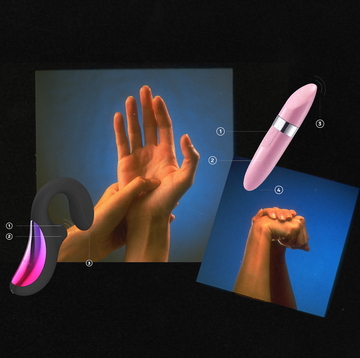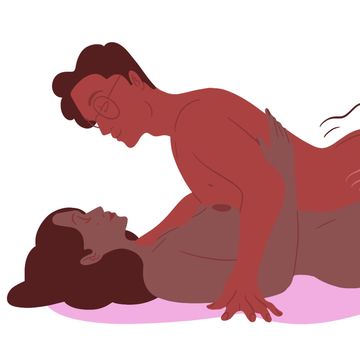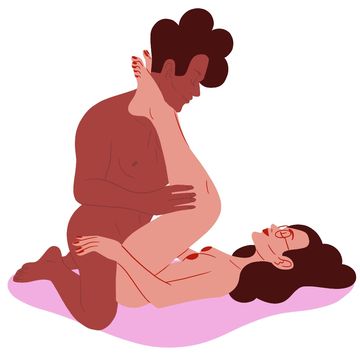One of very few things most people seem capable of agreeing on is that orgasms are awesome. A euphoric physical experience of erotic pleasure? Yeah, not much room for confusion or debate there! Something we’re not all quite on the same page about, however, is all the different *kinds* of orgasms out there—because, yes, there’s more than just one.
Even among the sexperts, there’s constant, swirling debate about the different types of orgasms women can have—clitoral, nipple, vaginal, and even mental. (And no, I don’t just mean thinking about a really good grilled cheese sandwich.) In the words of Atlanta-based sex coach and founder of Velvet Lips sex education center, Marla Renee Stewart, MA: “People can orgasm from all sorts of shit. From thinking about it, to nipples only, to needing genital stimulation, people come in all sorts of ways.” And while most aspects of female pleasure and biology are understudied, vaginal orgasms in particular seem to be especially mythic and misunderstood.
New York–based sex therapist and educator Lisa Hochberger defines a vaginal orgasm as “an orgasm from internal vaginal stimulation,” achieved through penetration, with a penis or a phallic item like a dildo. This is the kind of orgasm most likely to be broadcast in the mainstream: Think about how many movies you’ve seen where the only depictions of female pleasure—which tend to be hetero-centric—involve women having satisfying orgasms from no more than 10 seconds of kissing and vigorous Missionary with Some Dude. While it is totally possible to cum from penetration alone, vaginal orgasms (especially without any foreplay or prep) are by no means something the majority of women experience. Actually, the opposite may be true: Studies show that more than 75 percent of women need more than just penetration to orgasm, which is why many women may have more experience with clitoral or blended orgasms than vaginal ones.
While it’s important to note that no one type of orgasm is superior to any other—remember, all orgasms are good orgasms—ob-gyn Heather Bartos explains that vaginal orgasms tend to be deeper and involve more pulsating of the vaginal muscles than clitoral orgasms, which “tend to be lighter and more tingly.” No two people will experience the same kind of orgasm in exactly the same kind of way, obvi—orgasms are like special, sexy snowflakes—but your personal experience of a vaginal orgasm may feel very different from the clitoral orgasms you might be used to.
And that’s not all. We at Cosmopolitan recently uncovered that the G-spot, which was once assumed to be the magic ingredient for vaginal orgasms, doesn’t really exist. Going back even farther, in 2011, a Yale urologist speculated that the so-called G-spot was actually just an extension of the clitoris. But even if there’s no identifiable additional organ or muscle like a G-spot that makes penetration feel good, vaginal orgasms are still totally real for some women. And the reason why may surprise you.
How is it possible to have a vaginal orgasm if the G-spot isn’t real?
Basically, the explanation is that all orgasms—even the ones classified as vaginal—are technically clitoral orgasms. This means the clitoris is responsible for the feeling of a vaginal orgasm, which is confusing, of course, since clitoral orgasms are commonly associated with external stimulation only.
“All orgasms are clitoral orgasms,” explains clinical psychologist Brittany Blair, PsyD, CBSM, founder of the Lover.io app. Many people don’t realize that the external (aka visible) part of the clitoris is only the glans, while the body of the clitoris in its entirety extends up the vagina along the top of the vaginal wall and down behind the labia, Blair says. So while you might identify vaginal and clitoral orgasms as two different animals, the source of the pleasure actually comes from the same spot: the clitoris. It’s just that internal orgasms are the result of stimulation along the legs of the clitoris that you can’t see on the outside.
Sexologist Susan Kaye, PhD, explains that there are no nerve endings in the vagina itself (think about it: childbirth is painful enough) but that the feeling of vaginal orgasm comes from the backside of the clitoris and its nerve endings being stimulated. Just like how an iceberg is, like, 90 percent underwater, so is your clit. The clitoris that you can stimulate and see from the outside is just part of it. There are many nerve endings that carry sensation throughout your vagina that you can’t see from the vulva.
In the '60s, sexology pioneers William H. Masters and Virginia E. Johnson (remembered today as Masters and Johnson) broke barriers with their studies of orgasms and sexual stimuli, and some of their findings are still useful today. Hochberger, for example, cites Masters’ and Johnson’s “rule of thumb,” which she says identified “that if women had a thumbs length [...] between their vaginal opening and their clitoris they were more likely to have an orgasm from vaginal sex alone, and if they had more length they were likely to need more direct [external] clitoral stimulation to have an orgasm.”
And while certainly the genitals play a major role in most people’s pleasure, Stewart says there’s one other organ that dictates a person’s capacity to cum—and it’s located about two or three feet north, depending upon your anatomy. “There's so much debate about all the different types of orgasms, but the fact of the matter is the orgasm comes from the brain,” she says. “If we're turned off, most likely, we're not going to be able to have that orgasm.”
Penetrative vaginal orgasms are totally real, but unless you’re a Female Lead in a Hollywood blockbuster, the chances of one just springing up on you with no warning are slim to none. Like most other orgasms, they can require a bit of work and concentration before the pay-off in the form of all that brain-meltingly delicious pleasure. So without further ado, here are some tips from the experts on how to up your odds of having a vaginal orgasm—and really just an orgasm in general, because they’re all pretty similar and they’re all great.
How to have a vaginal orgasm:
If the clitoris is responsible for vaginal orgasms but you can access only a small portion of it externally, how do you stimulate the inner clitoris for a vaginal orgasm? The short answer: experimentation.
“It boils down to each woman discovering what works for her particular body,” explains Tazima Parris, intimacy coach. “Even if there were a particular ‘magic spot’ to stimulate or ‘perfect combination’ to use for orgasm,” Parris explains, “individual learning, curiosity, and exploration of one’s body is the best way to figure this out.” When experimenting in the hopes of discovering a vaginal orgasm, there are some things to keep in mind, says Parris.
1. Block off a good chunk of time to experiment.
Stewart emphasizes that orgasms, whether vaginal or otherwise, don’t just happen with a snap of your fingers or a clap of the hands. (Though a Clap-On orgasm would be dope.) “When I'm working with clients, a lot of times they want to rush to an orgasm or they give up after five minutes,” Stewart explains. “In a world where we want things instantly, we have to understand our bodies, and we have to be patient with ourselves when it comes to orgasm. It's important to give yourself time.”
How much time, you ask? Try at least 20 to 30 minutes of stimulation to achieve full arousal, Parris recommends, citing this Betty Dodson article she often uses as reference for clients. Parris suggests that instead of looking for a magic recipe or formula for a vaginal orgasm, the best thing you can do is adjust your expectations and work with your body.
“Be patient and romance yourself,” Stewart advises. “Instead of thinking 'I want to have an orgasm in 10 minutes,' take a bath. Light some candles. Seduce yourself. Take as long as you like, whether that's 30 minutes or an hour or whatever. Take the time to enjoy yourself. When we do that, we feel good and we're in our bodies and we take the pressure off of ourselves.”
2. Masturbate. Like, a lot.
In order to best discover your odds of a vaginal orgasm, Kaye suggests using a dildo, vibrator, and/or your own fingers. “Knowing your body, only you can educate a partner on what works best for you,” she explains. “Be your body’s own best friend. ‘Know thyself’ and then inform your partner by taking them on a tour.” After all, they’ll likely appreciate the helping hand.
3. Incorporate more foreplay.
To increase your chances of having a vaginal orgasm with a partner, Hochberger recommends upping your foreplay game stat.
A longer foreplay period— which might include oral sex, fingering, nipple play, role-play, and anything else that gets you all hot and bothered—helps bring you into the “meditative” state needed in order to orgasm, she says. “When [you are] breathing and moaning, you allow your muscles to relax and release,” Hochberger explains. “When we are self conscious, our muscles tense, which is the opposite of an orgasm. Pleasure is expansive.”
4. Try a suction sex toy.
Another tip, although more anecdotal than research-based (although for anyone who wants to throw a grant at me to study this clinically, hit me up), is to try suction-based sex toys. These toys are different from traditional vibrators in that they don’t just vibrate, but also have a small opening that creates a vacuum seal, isolating your clitoris for a very, very intense effect. Many of these toys promise to stimulate the inner legs of the clitoris that you can’t access externally, and while a marketing promise should always be taken with a grain of salt, those who have tried these toys say the orgasm does feel more intense and different from regular clitoral (aka external) orgasms.
5. Flex those pelvic floor muscles.
Some of the most important elements of a vaginal orgasm, Stewart says, are strong pelvic floor and core muscles. While she cautions against over-strengthening to the point that your pelvic floor muscles are too tight—you can only do so many Kegels!—regularly exercising those muscles is an important element of your capacity to orgasm from penetration. Stronger muscles will contract harder during orgasm, and Kegels promote blood flow to your pelvic area, which heightens arousal.
6. Focus on your breathing.
Stewart recommends trying what she calls “erotic breath work,” which typically involves breathing in through your nose and out through your mouth. You can try taking in a breath and holding it, then taking a few extra sips of air before an exhale. “I usually like to say breathe to the genitals,” she says. Then, squeeze your pelvic floor muscles and release on an exhale. Not only does this help regulate oxygen flow, but it can help you stay focused on the sensations happening in your body.
7. Know that your likelihood of having a vaginal orgasm may have to do with your own physical anatomy.
As Masters and Johnson observed, your odds of having a vaginal orgasm may also have to do with anatomy, Blair explains. Depending on how close your clitoris is to your vaginal wall or how deep it goes into your body may affect the sensation you can feel from your hidden clitoris nerves. That being said, remember that all orgasms are good orgasms, so if an internal or vaginal orgasm isn't possible for you, that's totally okay. External stim is just as delightful.
8. Brush up on your external clit stimulation while you’re at it.
As we’ve learned: Sufficient clit stimulation is tantamount to having even a vaginal orgasm. Megan Andelloux, executive director at the Center for Sexual Pleasure and Health, says most women find the upper left-hand quadrant of their clit the most receptive to stimulation. She also lists the most difficult orgasmic positions for women: 69ing, standing, and straddling a partner’s face, in case that also helps narrow down what not to spend time on.
9. Know the difference between what a vaginal orgasm and clitoral orgasm feel like, so you can identify them.
Again, all orgasms are technically clitoral orgasms, but the main difference between these two types of orgasm is where and how they are accessed. Clitoral orgasms are accessed through external clitoral stimulation, typically close to and around the head of the clitoris, explains Alisha Fisher, sexologist and relationship coach. Meanwhile, “a vaginal orgasm usually occurs through internal vaginal penetration.”
Okay, right, makes sense. But what’s the difference in terms of the actual experience of having these orgasms?
“Generally, [vaginal orgasms] involve rocking of the entire body and a big release when completed—about 10 to 30 seconds later,” explains Bartos. To make it even better, she says there’s a short refractory period for these types of orgasms as well. The clitoris, by comparison, is often “super sensitive after [orgasm], and a longer refractory period may be necessary.”
Because much of the clitoris is hidden beneath skin tissues, the sensitivity that people may experience with clitoral orgasms is due to the head of the clitoris rather than full clitoral stimulation itself.
“The intricate network of erectile tissue and nerves in your clitoris makes it your most acutely sensitive erogenous zone,” Fisher adds. “With over 77 percent of women saying that they need a build-up of arousal in order to achieve orgasm, placing a vibrator directly on the sensitive head of the clitoris can easily be too overwhelming.”
Colby Agostinelli, LMFT, CST, licensed couple and family therapist and AASECT certified sex therapist, says that some people may ultimately prefer one type of orgasm over the other, and those preferences are typically based on what kind of connection you want to feel, what you desire, and how your body responds to certain stimulation.
“If you experience vulvar or vaginal pain, your pleasure is likely to be focused on your clitoris, or wherever the pain is absent for you,” says Agostinelli. “If you have a very large glans clitoris, you may experience heightened sensitivity that makes direct stimulation feel more painful than pleasurable, so you may favor indirect stimulation through the vagina instead.”
In other words, Agostinelli adds, “Context and individuation are everything!”
10. Understand that it’s possible for you to have already experienced a vaginal orgasm without knowing it.
So, don’t be discouraged if you feel like you’re missing out on a huge part of sex just because you’ve never felt a definitively “vaginal” orgasm. “Oftentimes, when I ask women if they experience their orgasm clitorally or vaginally, they will say that they can’t really tell the difference of exactly where it’s happening, since both areas are being stimulated,” explains Liz Miracle, MPST, WCS, a Bay Area clinical director, educator, and physical therapist at Origin.
Miracle suggests it may have something to do with “referral,” or the phenomenon where your body experiences one thing but you feel it in another area. When a woman has a heart attack, for example, she might feel it in the center of her shoulder blades or feel “heartburn,” Miracle adds. A man, on the other hand, might feel it in his sternum or as pain in the left arm. “The point being, something can happen in one location and be sensed in a different area of the body. This may have to do with how our brain is receiving the sensory input or where the actual path of the nerves lies,” Miracle says.
11. Seriously, it bears repeating: Do not feel like there’s something wrong with you or think that your sex life is lacking if you can’t have a vaginal orgasm.
Bartos also agrees with the consensus that “it is possible to have [a vaginal orgasm], but it’s definitely not the norm. In fact, it may be the sexual unicorn [of orgasms].” Unfortunately, it’s hard to quantify exactly what percentage of people can have vaginal orgasms since, as Bartos points out, orgasms are a complicated business. There are a huge number of factors that play into how each and every orgasm is a little different—anatomy, masturbation or sex technique, and even where you are in your cycle can affect your orgasms. Not to mention your partners, relationship, and trust level often required to really let yourself go.
12. Remember, the whole point (and likely the reason you found this page) is to focus on your pleasure.
All orgasms are good orgasms because, well, they’re orgasms. Feel empowered by the fact that you ultimately just want to know your body better, and treat the experimentation toward vaginal orgasm as a journey. If you view the road traveled in pursuit of the mythic vaginal orgasm as a cause worthy in itself, it’ll also likely help with your own expectations. Maybe you can’t have a vaginal orgasm, but you discover, like, 26 new ways for you to orgasm clitorally in the process. That’s a win too.


Emma Glassman-Hughes (she/her) is a freelance writer for Cosmopolitan and a part-time editor at the Boston Globe. She was formerly a staff writer at Elite Daily, where she covered sex, intimacy, and queer topics. She is a graduate student at Boston University, where she’s pursuing a master’s in journalism with an emphasis on narrative and investigative reporting. She has a Twitter but her website is way more fun.








